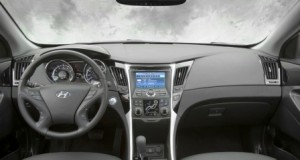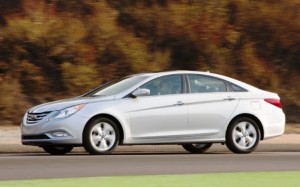There is no question that Korean automaker Hyundai is doing well in the unprotected U.S. market. The industrial giant has picked up two market share points this year as its relentless pace of new product introductions and savvy marketing and advertising left domestic and Japanese competitors in its rearview mirror.
Increasing sales in a depressed market is no mean feat. Moreover, it is now clear that Hyundai is moving into its next phase of expansion.
So here comes the sixth generation Sonata, already on sale elsewhere, to do battle with a weakened Honda, severely wounded Toyota, as well hapless General Motors and Chrysler, among others. Sonata is aimed at the very heart of the expanding mid-size car market and brings to the sales battle both technology and fuel economy boosts that have promotional and, depending on how you view the styling, emotional appeal.
Hyundai designers started working about three and half years ago on what the company is promoting as “Fluidic Sculpture.” Leaving aside the styling babble, it is an attempt to use lines and curves in a way that is said to create the illusion of motion. As to how successful it is we will leave for you to judge.
The sweeping roofline potentially creates a rear headroom problem that designers got around by lowering the h-point of the seats. What this means in practice is a less than ideal seating position where your knees are up much higher than your bottom, which after a while is uncomfortable.
More successful, on paper at least, is the new four-cylinder engine.
The so-called Theta II 2.4-liter four-cylinder engine uses a direct-injection fuel delivery system, which contributes to improved fuel efficiency and lower emissions. This makes Sonata the first mid-size sedan to adopt this technology as standard equipment in a naturally aspirated powertrain.
Direct injection also uses a higher than normal 11.3:1 compression ratio for increased power. This powerplant is said to deliver best-in-class fuel economy, best-in-class four-cylinder horsepower and best-in-class torque.
Sonata’s EPA ratings are projected to be 23 mpg city, 35 mpg highway with the optional six-speed automatic transmission. When equipped with the six-speed manual, the Sonata is rated at an estimated 23 mpg city, 34 mpg highway.
The preliminary horsepower and torque ratings for the Theta II GDI are 198 horsepower and 184 lb.-ft. of torque. In the SE trim, which includes a standard dual exhaust, the engine delivers 200 horsepower. This all-aluminum, 16-valve engine features Continuously Variable Valve Timing (CVVT) on both camshafts and a Variable Induction System (VIS) for better engine breathing. A version of this engine also meets Partial Zero Emission Vehicle (PZEV) standards.
|
2011 Sonata |
2010 Camry |
2010 Accord |
2010 Altima |
2010 Fusion |
2010 Malibu |
|
| Engine |
2.4L I4 |
2.5L I4 |
2.4L I4 |
2.5L I4 |
2.5L I4 |
2.4L I4 |
| Horsepower |
198 @ 6300 |
169 @ 6000 |
177 @ 6500 |
175 @ 5600 |
175 @ 6000 |
169 @ 6400 |
| Specific output (HP/Liter) |
82.5 |
67.6 |
73.8 |
70.0 |
70.0 |
70.4 |
| Torque |
184 @ 4250 |
167 @ 4100 |
161 @ 4300 |
180 @ 3900 |
172 @ 4500 |
160 @ 4500 |
| Fuel economy (A/T) |
23/35 |
22/33 |
22/31 |
23/31 |
23/34 |
22/33 |
–

Large size interior in a mid-size car is arguably best in class. The rear seats are compromised, though.
Next year, Hyundai will add a 2.0-liter Theta II turbocharged direct-injection four-cylinder engine and a 2.4-liter “Hybrid Blue Drive” model with a lithium polymer battery pack. Details about these powertrains will be announced at the 2010 New York Auto Show.
Sonata continues with Electronic Stability Control (ESC) as standard equipment. It also has a four-wheel disc brakes and an Anti-Lock Braking System (ABS) including Brake Assist, which provides maximum braking force when a panic stop is detected, and Electronic Brake-force Distribution (EBD) to adjust the braking force at the front and rear axles based on vehicle load.
Sonata also has six airbags—including dual front, front seat-mounted side-impact, and front and rear side curtain airbags—along with active front-seat head restraints. The 2011 Sonata model will earn NHTSA’s top rating of five-stars for front and side impacts, according to Hyundai. Other “passive” safety features include shingle-style rear-seat head restraints for improved visibility, three-point seatbelts for all seating positions, front-seat seatbelt pretensioners and force limiters, and rear-seat anchors and tethers for child seats.
–
|
2011 Sonata |
2010 Camry |
2010 Accord |
2010 Altima |
2010 Fusion |
2010 Malibu |
|
| Passenger volume (cu. ft.) |
103.8 |
101.4 |
106.0 |
100.7 |
100.3 |
97.7 |
| Cargo volume
(cu. ft.) |
16.4 |
15.0 |
14.0 |
15.3 |
16.5 |
15.1 |
| Total interior volume (cu. ft.) |
120.2 |
116.4 |
120.0 |
116.0 |
116.8 |
112.8 |
| EPA size classification |
Large |
Midsize |
Large |
Midsize |
Midsize |
Midsize |
–
Sonata is the second vehicle in Hyundai’s latest product initiative, which will see seven revised models appearing during the next 24 months. The revised Tucson and Sonata are now in production at Hyundai’s U.S. plant in Alabama. Sonata retail sales begin in January, and if the current pricing philosophy holds, it will be less expensive than Camry and Accord.

